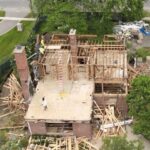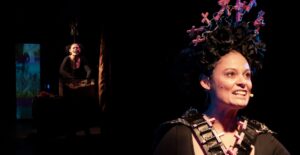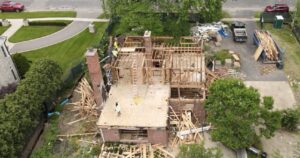Visual storyteller, placemaker, educator, and artist, Olayami Dabls has been collecting beads for 23 years.
Why?
Because he sees them as rich symbols of African culture, history, and communication. To Dabls, each bead tells a story, representing aspects of African identity and heritage.
Dabls launched the Dabls MBAD African Bead Museum in 1998 as a way to preserve and share these cultural narratives, helping others to connect with and understand the deep significance behind these objects.
The Dabls “campus” houses a sculpture garden with 18 outdoor installations, the African Bead Gallery, the N’Kisi House, and the 150-ft. African Language Wall which has become a beacon for thousands of visitors globally.
Detroitisit had the unique opportunity of sitting down with Dabls to get more insights behind the beads, the museum, and his “why.”
DII: What is the Dabls MBAD African Bead Museum?
Dabls: It is a community-based bead museum founded in 1996 and featuring hundreds of thousands of beads, some that date back to the 1700s.

BEAD GALLERY
DII: Tell us about your journey as an artist and how you came to where you are today.
Dabls: I started in the 1970s primarily as a portrait painter, exploring various subjects. As I delved deeper into my work, I began to realize that the term “art” might not be the most accurate way to describe the cultural expressions I was encountering. People often ask about art, but they don’t always refer to it in the same way across different cultures. What some might call “art,” others might see as “material culture.”
As I studied more, I understood that what we often label as “art” is really about communicating information—sharing ideas, concepts, and stories that are vital to a community. I came to see that “storytelling” might be a more fitting term. What we traditionally call “art” is often about conveying messages and reflecting on things that impact individuals and cultures.
The more I explored, the clearer it became that my work was not just about painting pictures or illustrating scenes. It was about discussing and expressing the things that affect people and cultures in meaningful ways.
DII: So what inspired you to open the Dabls Bead Museum and what are you looking to create here for yourself and others?
Dabls: First, I want to address the concept of “inspiration.” It’s an emotional concept, but when people ask about culture, they don’t often think of it in emotional terms—they think of it as something that records certain events. The idea of “inspiration,” especially in the context of our culture, is relatively new. Before 1965, African Americans didn’t have a museum or gallery dedicated to our culture, so the concept of preserving our history through a museum is something we’ve come to later than others.
Our history is passed down through artifacts, stories, and materials, and I’ve always felt the need to fill in the gaps in that history. I realized that our brains hold information from generations before us, which we add to and expand upon. All of these elements come into play in what I do.
The idea to open the bead museum came from my observation that beads are a universal form of communication about culture. There isn’t a person on the continent who hasn’t used beads in some way to convey information about their culture. I began to collect information about these pieces, and before I knew it, I had a museum that, to my amazement, connected with people all over the world.
Every culture on this planet has a relationship with beads, and we’ve had visitors from all over the world who have come to see the collection, often just by word of mouth.
DII: Where do you source the beads and other materials from?

BONE BEADS
Dabls: We source many of our beads from Africa, following the traditional routes through which beads have traveled over the centuries. Historically, individuals would carry beads across the world, but with the rise of the internet, this long-standing tradition is changing. We’re now in the middle of a transition where beads are being traded and sold online rather than through physical travel.
Today, many beads are found in collections and museums. Scholars began paying close attention to beads in the 1980s, recognizing their significant role in social groups and cultures. Over time, beads have evolved as a unique way of communicating information.
DII: What types of patrons do you have?
Dabls: We attract a diverse group of visitors who are curious about the history and cultural significance of beads.
What do the beads and materials in the museum mean to you personally?
To me, they represent the idea that traditional information—often shared orally and passed down through stories—contains some of the most important insights. It’s about preserving and sharing knowledge in a way that resonates with our heritage.
DII: The museum consists of nearly an entire city block – elaborate on what it includes.
Dabls: The museum features a diverse range of installations. These installations were introduced to attract visitors by enhancing curb appeal.
For 23 successful years, the museum has thrived due to these engaging installations and its gallery. Although often mistakenly referred to as a museum, its primary focus has been on offering a dynamic experience rather than rigidly defining its exhibits.
The museum’s approach has always been to display items in a way that allows visitors to form their own interpretations and enjoy the experience. The goal is to present items from various cultures in a manner that resonates with visitors and evokes personal connections, enhancing their overall enjoyment.

BEAD GALLERY
DII: What about the recently demolished building on your site?
Dabls: We had the roof fall in on one of our buildings. There was some confusion when people saw the building labeled as the bead museum. Many people think the gallery is the museum and people assumed this was demolished after the roof fell. But in reality, the museum was never fully realized in that building. The gallery itself has been around for 25 years, sharing the fascinating history of beads, which have existed for 30,000 years and continue to capture people’s interest. The gallery is still thriving.
We’ve started a GoFundMe to raise $60,000 to $70,000 for a new building that will have a dedicated museum space.
DII: What is the future of the museum?
Dabls: What we’ve achieved so far, without significant financial backing but with great determination, has been incredible.
The goal is to fully establish the new building and new museum space and display our collection for everyone to enjoy.
The future is promising. At least 30% of visitors who come to museums in Detroit seek us out, showing that bead museums remain quite popular.
As always, be sure to subscribe to our newsletter for regular updates on all things Detroit and more.






















